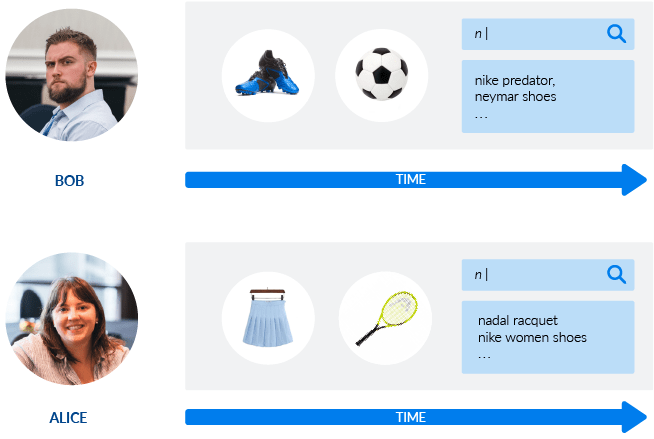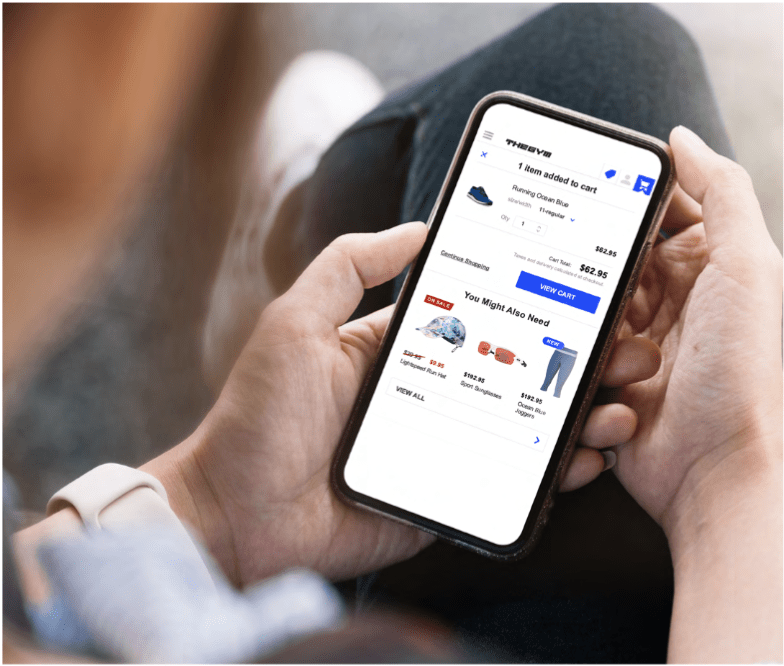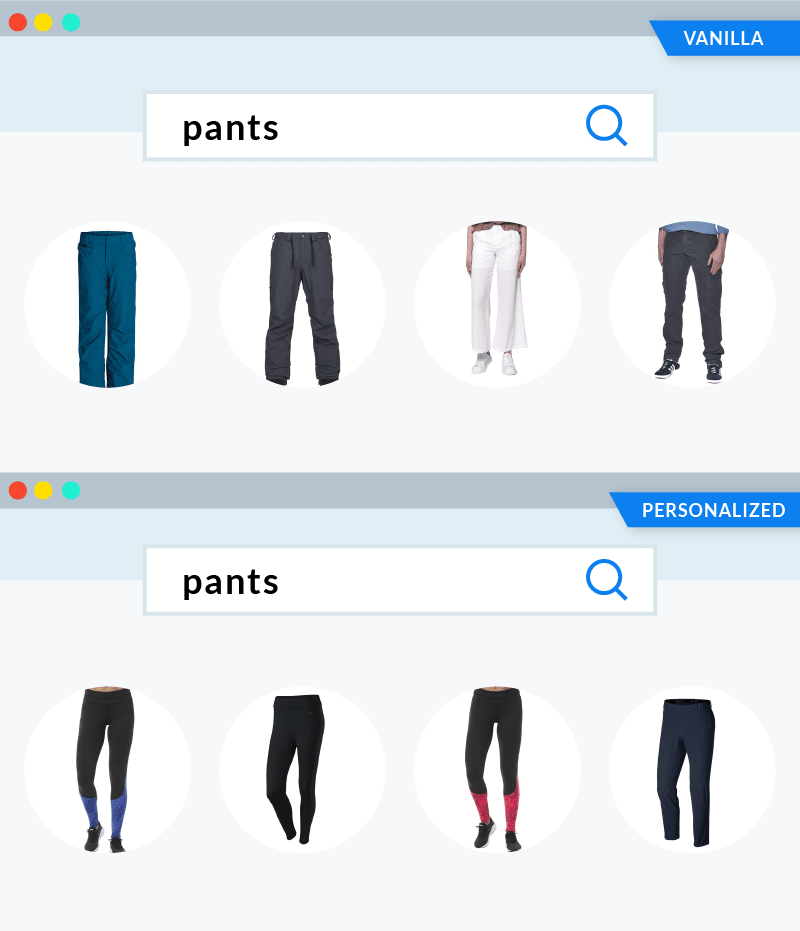Digital retailers are sensitive to wanting to provide relevant experiences to people. But it turns out that relevance is highly nuanced, particularly in Ecommerce. And it is even harder to achieve.
What Is Relevance in Ecommerce? And why do you need it?
True Ecommerce relevance is the ability to allow a shopper to find what they need to fulfill the intent they carry at a specific point in time and within a particular context – even if that shopper isn’t entirely sure what is needed to fulfill that intent. That makes a relevant experience one that seamlessly leads a shopper to what they need. And it should engender the same feeling of ease that comes when interacting with a knowledgeable, intuitive sales person.

For any particular shopper, what constitutes a relevant experience can be nuanced, ephemeral, and difficult to put into words, as their needs constantly change. For this reason, it can be complicated for a digital retailer to figure out how to continuously deliver such an experience.
For example, a shopper might be looking for gear for a scuba diving trip one day and jewelry for her husband as an anniversary present the next. Despite being the same person, she will have different needs and will require different guidance to find what she is looking for. And just like any other modern-day shopper, she expects that her varying needs will be known and acted upon accordingly.
The reality is that relevance in Ecommerce is not a superpower but rather a baseline capability – it is now expected. Digital giants like Google and Amazon have taken the process of finding products and information to a new level, conditioning users of these ubiquitous platforms, like our scuba-diving wife, to expect the same level of intelligent experiences everywhere.
What Shoppers Expect
In fact, more than half (53%) of the consumers responding to aRedPoint Global survey conducted by The Harris Poll said they expected brands to “know their buying habits and preferences and to be able to anticipate their needs.” And consumers immediately respond when they are not recognized as individuals, the survey shows.
Thirty-four percent become “very frustrated” when a company sends them an offer for something they just bought, and 33% feel the same way when they receive “offers that aren’t relevant to me or that I wouldn’t be interested in.”

Ultimately, when it comes down to it, achieving relevance in digital commerce means the difference between…
…Buy or Bounce
…Add to Cart or Abandon Cart
…Include more or check-out now
And that means digital retailers must figure out how to deliver a seemingly infinite number of experiential permutations overnight – thankfully, there is a way forward with AI.
In Episode 4: The Next Generation of Retail commerce of our podcast, The Ecom Edge, Cate Trotter, Head of Trends at Insider Trends and Sergio Iacobucci, eCommerce Product Manager at Coveo, spend 30 minutes discussing pressing questions in the retail world about online shopping vs in-store shopping. Tune in to find out how retailers can keep up with rapidly evolving consumer expectations and more!
Mastering Relevance: Emulate the Best In-Store Experience
Just as mass merchants have a different go-to-market model and appeal than more specialized retailers, the Ecommerce sector — which has grown greatly since the pandemic started — has room for multiple approaches to mastering relevance.
Most Ecommerce players can’t come close to the technical capabilities of an Amazon or Wayfair, but they don’t have to. In fact, “it’s a bad idea,” says Ciro Greco, director of AI at Coveo. “If I applied Amazon’s code base to Coveo’s Ecommerce clients, none of it would work, and that is for the same reason that none of the things that would be good for basketball legend LeBron James make sense for an ordinary guy.”
Most digital retailers have been led to believe that AI cannot be applied to their search, recommendation, and personalization applications because they don’t have enough data, but that misconception is based on the idea that they are limited to using historical data only.

Simon Langevin, director of product management at Coveo for Commerce, explains that AI actually works better when it uses in-session data generated by site visitors and product data in addition to a retailer’s historical data, which reveals patterns that are endemic to the site, to produce the kind of relevant experience that the best retail stores offer through human-to-human interaction.
“Bringing back expertise that was lost from brick-and-mortar stores and bringing it online is an extremely important part of relevance,” Langevin says. As an example he offers, “You enter a store and ask for gloves. The associate’s first question would be, ‘What kind of activity or occasion do you need gloves for?’ Even better, a salesperson who knows you would say, ‘I know you’re a skier. Are you interested in ski gloves? I can walk you to our assortment and help you choose. I can also share some intel on the highest-rated ski gloves for 2021.’”
Relevance Comes at the Intersection of Three Key Technologies
By bringing search, recommendation, and personalization technologies together, and applying AI across the trio, digital retailers can inject relevance into every interaction at every touch point so that shoppers find what they need with less effort.
It is important to recognize that all three are required and inherently linked, as each plays a role in both providing the experience and capturing behavioral data to improve the relevance of the experience. Interactions in the search box inform recommendations, and vice versa, and both forms of interaction should influence the personalization of product rankings, etc.
Shopping Starts With Search
Search is the entry point for consumers looking to find what they need, and search inadequacies and problems are typically the impetus for retailers to begin to address the larger issue of relevance. Greco notes that many retailers come to Coveo to “fix search and never talk about it again,” but search will never stand still. Consumer behaviors are constantly changing, new types of search (such as voice and image search) arise, and brands will always introduce new products.
Because search is an invaluable tool for consumers and a conversion engine for retailers, the technology is being constantly improved, with the AI functions of Machine Learning and Natural Language Processing enabling search to “learn” from the data without human intervention.
The Wall Street Journal recentlycovered the latest advancements in search technology for its business-oriented consumer audience: “Taken together, Natural Language Processing, computer vision (object recognition in images), and vast stores of customer data enable online retailers to better interpret a search query, identify a more precise set of relevant products, and pull out a smaller assortment of personalized choices unique to each shopper.”

For an Accenture blog, search specialist Phil Lewis wrote that the firm “learned from first-hand experience that e-commerce site search performance does have a measurable impact to the bottom line. A modification or improvement to a particular search functionality can produce a correlated increase in conversion rate, and thus overall e-commerce revenue.”
Personalized Recommendations
Recommendations are such a powerful tool that Netflix built an empire around them. “Our business is a subscription service model that offers personalized recommendations,” the video streaming service explains. “We take feedback from every visit to the Netflix service and continually retrain our algorithms with those signals to improve the accuracy of their prediction of what you’re most likely to watch.”
In Ecommerce, recommendations are the key to boosting order size. Through large-scale website usability testing, Baymard Institute found that “recommendations and offers that are highly relevant to the items in the cart were observed to encourage user engagement, which can lead to increased order totals and an overall positive impression of the brand.”

However, consumers are wary of recommendations that seem to be in the retailer’s interest only. “Suggesting products that are not obviously related to the cart contents, or to the item just added to the cart, can erode a user’s confidence in the site and all of its recommendations — even relevant ones,” according to Baymard. Irrelevance is costly.
This finding does not mean that retailers should put aside their business interests to please customers. Greco says, “There’s a natural tension between what a user perceives to be relevant and what an Ecommerce site chooses to optimize as a business.”
He adds that retailers must balance customer-centric experiences that build loyalty with business decisions that aim to increase conversions and basket size, comply with vendor promotions, upsell and cross-sell, and direct customers to the most profitable offerings.
What is interesting is that many digital retailers think of recommendations separately from search and fail to understand the intimate connection between the two. The data collected by search can and should be used as essential fuel to power more relevant recommendations throughout the site.
Personalization
Personalization has been held up as the Holy Grail by businesses adopting a customer-first posture, which is a recognition that consumers empowered by the Internet are not waiting for marketers and advertisers to tell them what they should want or buy.
In the RedPoint Global survey, 63% of consumers reported that personalization is now part of the standard service they expect, and 37% said they would “stop doing business with a company that doesn’t offer a personalized experience.”

Ecommerce companies get it. In aDigital Commerce 360 survey of retailers conducted last year, 47% of respondents said a portion of their 2021 investments in Ecommerce technology would go toward “providing better personalized shopping experiences.”
It is important to note that the personalization that consumers seek and that retailers aim to deliver – the type that contributes to relevance – is about far more than [insert individual’s name here] gimmicks. True relevance is dependent on true personalization, meaning that each and every aspect of the experience needs to be tailored to the individual user and have the ability to adapt in time and over time.
This can take the form of:
- Predictive category suggestions: If a shopper has looked at a wide range of golf-related products, and then they start to search for gloves, they should be prompted with a drop-down suggestion for “gloves in golf”.
- Discovery tags: If a shopper has looked at a wide range of golfing products, and then searches for “Nike”, they should be presented with quick filter tags such as “shoes” and “gloves” to help them narrow down the range of products quickly.
- Dynamic facets and filters: If a shopper is looking for a square table, they should not see or have to apply a filter for “shape”.
- Intent aware product ranking: If two twenty-year-old women looking for shorts have very different ideas of what they want to find, then those differing intents should be reflected in the products they see. What is appropriate for one may not be appropriate for the other, even if they fit the same demographic mold.
Bring It All Together With Applied AI
Bringing search, recommendation, and personalization technologies together without AI is like having a racecar without an engine – you might look like you can compete, but the reality is that there is absolutely no horsepower to help you do so. Now, AI is a term that’s grown vague in its ubiquitousness, so let’s dig into why and how it should be used in the context of Ecommerce. Greco has some very clear guidance to share on this one:
“The recipe for good usage of AI in your business is a function of two things:
- Profound, deep knowledge of your business problem
- Great technology
The first one without the second one is helpless. And the second one, without the first one is useless.”
The best problems to solve with AI are those that are 1) repetitive 2) near real-time 3) multi-factor (meaning that finding an optimal output requires taking several sources of data into account). And, of course, those that are 4) data driven.
So Ecommerce experiences are prime candidates for applying AI. And doing so is actually critical, as it is what will enable you to generate the horsepower required to make your online experiences just as personal and intimate as a traditional in-store transaction with a friendly and knowledgeable sales associate.

The Choice Is Yours
Retailers, and particularly omnichannel retailers, are in the midst of another challenging year as they cope with uncertainties around the course of the pandemic and its effect on the economy. But the outlook is not bleak for organizations that choose to make the most of unstable conditions to improve their competitive position.
When it comes to the relevant experiences that today’s consumers have come to expect, most retailers can now access the search, personalization, and recommendation technologies, and underlying AI capabilities, that they need to deliver.
While attaining these capabilities once required a team of data scientists, they have since been democratized by the rapid development of cloud capabilities, the advancement of pre-packaged Machine Learning models and data analytics, and the efforts of vendors to turn what was once known as search into an ecosystem geared towards mastering relevance.
Dig Deeper
Capturing what a relevant experience looks like is difficult, because it just works. The impact of relevance is actually best revealed by looking at what happens without it:
Watch this bite-sized learning series “7 Turnoffs that Make Shoppers Abandon You” to discover what’s standing in the way of delivering the friction-free experiences that shoppers expect.
Interested in more on personalization for ecommerce? Then this 6-minute read on personas vs personalization will get you started.



